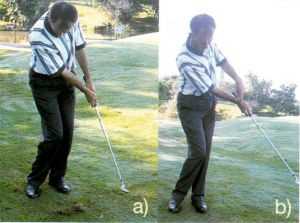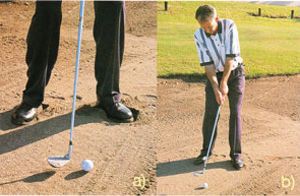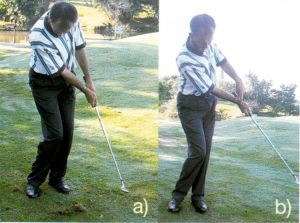The set up:
For the straight forward chip shot, the address position should be compact – with the feet relatively close together and slightly open (parallel to a line pointing just left of target). Importantly, the weight must favour the left side, with the ball placed back in the stance. The club is very much an extension of the left arm – you are comfortably over the ball without feeling cramped or that you have to reach towards the ball.

Pictures a) & b)
Shot execution:
All too often I see short backswings with a long follow through. This can cause problems – practise lengthening the backswing a bit, but keep the follow-through compact and controlled (a). Most importantly, the angle formed by the right wrist and arm must remain constant throughout the stroke (b).
Club selection:
The old adage, “if you have the green to work with, use it”, is quite valid. Once the correct technique for executing the chip shot has been mastered, the right club for a given situation must be selected. Experiment by playing shots from different positions near the green, with the aim being to use the available putting surface. Remember, whether using a 7-iron to produce more roll, or a wedge to carry the ball over a bunker or pond, the same basics apply.

Pictures a) & b)
Bunkers:
Once chipping becomes less of a fear, you are ready to work on bunker shots. Most golfers know that to play this shot correctly, the club-head of the sand-wedge must effectively slide under the ball, entering the sand behind the ball. (The less sand trapped between the clubface and the the ball, the greater the club-head speed, therefore the further the ball will carry.)
Firstly, the clubface must be set in an open position (a) and gripped accordingly (b). Do not grip the club with the leading edge in a square position and then rotate the hands so that the face opens.
Right-hand drill:
The role of the right side cannot be over-emphasised and playing right-handed chip shots is an excellent way of developing right-side control. Here the aim is to maintain the angle between the right wrist and arm throughout the shot. One of the common faults is to attempt to ‘scoop’ the ball into the air – trust the loft on the club to do the work. If the wrist angle remains constant and crisp contact is made with the ball by hitting down and through, the battle is almost won. With practise you will develop a feel for distance, but first the fundamentals must be correct.
Check:
It is a good idea when practising the chip shot to pause at the top of the backswing and check the angle of the wrist – it must remain constant from address.
The so-called ‘yips’ are a mental condition and, although psychologists are baffled by it, it is no secret that it is born out of lack of confidence. By employing a technically incorrect method, a golfer is likely to find all sorts of errors creeping into the stroke and loss of confidence will result. Moving over the ball (changing the angle of the spine) is likely to cause shots that are hi “thin” or “in the teeth” (hen the ball is struck with the leading edge of the club). or “fat” (when the leading edge of the club digs into the turf behind the ball).



